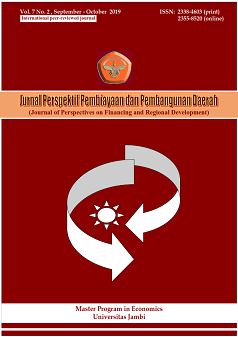Comparison of fuzzy clustering methods in economic freedom ranking in Asia-Pacific
DOI:
https://doi.org/10.22437/ppd.v7i2.7872Abstract
Economic freedom can be defined as freedom in which individuals can perform their economic activities freely without being exposed to the pressures and constraints. The aim of the studies on the classification of countries according to their economic freedoms is to determine the place of the countries in the world or in the continent where they are located. In this way, the status of the countries with sustainable growth and high welfare is determined. In this study, it is aimed to rank Asian countries according to economic freedom data. In contrast to many classifications and sorting studies, the present study attempts to determine the best sorting method by comparing multiple methods. As a result of the economic freedoms published by the Heritage Foundation every year, the conditions of Asian countries between 2015-2019 were determined. Fuzzy C-Means, Gath-Geva and Gustafson-Kessel methods, which are the three most commonly used methods, were used in the fuzzy clustering analysis. The results obtained from all fuzzy clustering methods were compared and interpreted with the results of the Heritage Foundation year by year. According to all analysis results, it can be said that the Fuzzy C-means method is more successful for Economic Freedom data and classification studies. According to the Fuzzy C-Means method, the three best Asian countries were Hong Kong, New Zealand and Australia respectively
Downloads
References
Abonyi, J., & Feil, B. (2007). Cluster Analysis for Data Mining and System Identification. Springer Science & Business Media, 1-45.
Balasko, B., Abonyi J., & Feil B. (2005). Fuzzy Clustering and Data Analysis Toolbox. Univ. of Veszprem, Hungary.
Bezdek, J.C. (1974). Cluster Validity with Fuzzy Sets. J. Cybern. 3(3), 58-73.
Bezdek, J.C. (1981). Pattern Recognition with Fuzzy Objective Function Algorithms. Plenum Press, New York, USA.
Dunn, J.C. (1973). A Fuzzy Relative of the ISODATA Process and Its Use in Detecting Compact Well-Separated Clusters. Journal of Cybernetics, 3(3), 32-57.
Erilli, N.A. (2018). Proposed Index Calculation For Economics Ranking. Balkans JETSS, 1(1), 94-102
Erilli, N.A., Yolcu, U., Egrioglu, E., Aladag, C.H., & Oner, Y. (2011). Determining the Most Proper Number of Cluster in Fuzzy Clustering by Artificial Neural Networks. Expert Systems with Applications, 38(3), 2248-2252.
Gath, I., & Geva, A.B. (1989). Unsupervised Optimal Fuzzy Clustering, IEEE Transactions on Pattern Analysis and Machine Intelligence, 11(7), 773-780.
Gustafson, D.E., & Kessel, W.C. (1979). Fuzzy Clustering with a Fuzzy Covariance Matrix. IEEE CDC San Diego, 761-766.
Höppner, F., Klawonn, F., Rudolf, K., & Runkler, T. (1999). Fuzzy Cluster Analysis, Wiley & Sons, USA.
Naes, T., & Mevik, T.H. (1999). The Flexibility of Fuzzy Clustering Illustrated By Examples, Journal of Chemometrics, 13(3-4), 435-444
Oliveira, J.V., & Pedrycz, W. (2007). Advances In Fuzzy Clustering and Its Applications, John Wiley & Sons Inc. Pub., West Sussex, England.
Ruspini, E.H. (1973). New Experimental Results in Fuzzy Clustering. Information Science, 6, 273-284.
Sintas, A.F., Cadenas, J.M. & Martin, F. (1999). Membership Functions in the Fuzzy C-Means Algorithm, Fuzzy Sets and Systems, 101(1), 49-58.
URL-1: www.heritage.org
Downloads
Published
How to Cite
Issue
Section
License
Copyright (c) 2019 Necati Alp ERILLI

This work is licensed under a Creative Commons Attribution 4.0 International License.

















